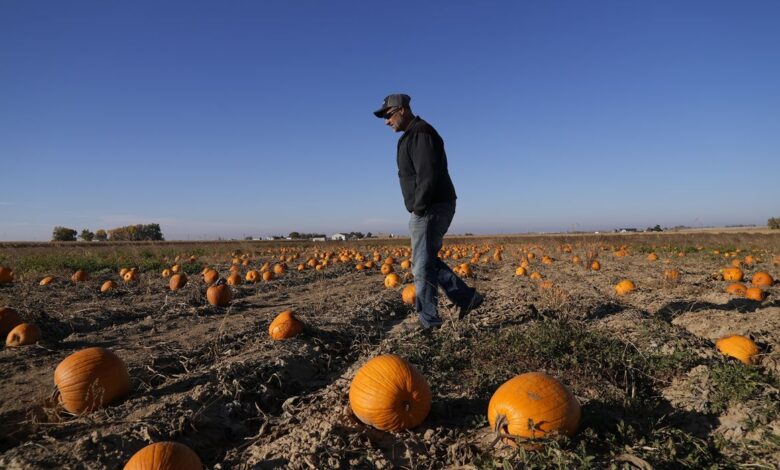
In the United States, pumpkin growers are facing challenges in harvesting due to unusual weather patterns. Farmers across states like Texas, New Mexico, and Colorado are experiencing water shortages and extreme heat, which is affecting their pumpkin crops. As human-caused climate change exacerbates drought and heat extremes, agriculture is suffering, leading to a decrease in predicted yields and increasing costs for farmers.
Alan Mazzotti, a pumpkin farmer from Colorado, faced a reduced water delivery this year, leading to him planting only half of his typical pumpkin crop. The heavy rains in May and June further disrupted planting opportunities for many farmers. Mark Carroll, an extension agent for Floyd County in Texas, refers to this year as one of the worst in recent years for pumpkin harvesting. The hot and dry weather, combined with water shortages, impacted the survival of pumpkins, which require cooler temperatures during the harvesting and shipping process.
The rising cost of irrigation is another concern for pumpkin farmers. Groundwater levels are dropping, driving up energy expenses used to pump water. Lindsey Pyle, a farmer from North Texas, witnessed a 20% loss in yield and highlighted the difficulty in predicting pumpkin growth earlier in the season. This uncertainty in water availability affects the choices farmers make in selecting crops to grow.
Steven Ness, a farmer from New Mexico, emphasized the long-term problem of groundwater depletion and the lack of rain and snow caused by climate change. He mentioned that the increasing cost of irrigation influences farmers’ decisions and profitability. Jill Graves, a farmer from Texas, had to source pumpkins from a wholesaler instead of growing them due to challenges in the harvesting process.
The impact of climate change on pumpkin farming goes beyond water scarcity. Labor costs have also become a pressing issue. Pumpkins cannot be harvested by machines like corn, requiring significant labor for the picking and preparation process. Farm labor laws, such as overtime pay, add further financial strain to farmers’ operations, particularly in states like Colorado. These farmers are faced with a “no-win situation” of increasing costs and labor challenges.
The pumpkin industry in Illinois had a successful harvest, contrasting with the difficulties faced by growers in Southwestern and Western states. However, the overall impact of climate change on pumpkin farming is a growing concern, with implications for future generations of farmers. Despite the challenges, some farmers remain optimistic and plan to continue growing pumpkins in the years to come.
In conclusion, unusual weather patterns and the effects of climate change on water scarcity and extreme heat are impacting the pumpkin harvesting industry in the United States. Farmers are facing reduced yields, increasing costs, and labor challenges. However, there is a determination among some farmers to continue growing pumpkins, despite the uncertainties they may face in the future.
Unique Perspective: While the impact of unusual weather on pumpkin harvesting is a concerning issue for farmers, it also reflects the broader effects of climate change on agricultural practices. As weather patterns become more unpredictable, farmers must adapt and find sustainable solutions to ensure food production. This highlights the urgent need for environmental awareness and global efforts to mitigate the effects of climate change on our food systems.




